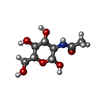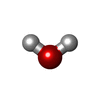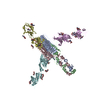+Search query
-Structure paper
| Title | Structural basis for immune cell binding of via the trimeric autotransporter adhesin CbpF. |
|---|---|
| Journal, issue, pages | Proc Natl Acad Sci U S A, Vol. 122, Issue 15, Page e2418155122, Year 2025 |
| Publish date | Apr 15, 2025 |
 Authors Authors | Gian Luca Marongiu / Uwe Fink / Felix Schöpf / Andreas Oder / Jens Peter von Kries / Daniel Roderer /  |
| PubMed Abstract | (Fn), a commensal in the human oral cavity, is overrepresented in the colon microbiota of colorectal cancer (CRC) patients and is linked to tumor chemoresistance, metastasis, and a poor therapeutic ... (Fn), a commensal in the human oral cavity, is overrepresented in the colon microbiota of colorectal cancer (CRC) patients and is linked to tumor chemoresistance, metastasis, and a poor therapeutic prognosis. Fn produces numerous adhesins that mediate tumor colonization and downregulation of the host's antitumor immune response. One of these, the trimeric autotransporter adhesin (TAA) CEACAM binding protein of (CbpF), targets CEACAM1 on T-cells and has been associated with immune evasion of Fn-colonized tumors. Whereas the role of CEACAM1 in homophilic and heterophilic cell interactions and immune evasion is well described, the mechanistic details of its interaction with fusobacterial CbpF remain unknown due to the lack of a high-resolution structure of the adhesin-receptor complex. Here, we present two structures of CbpF alone and in complex with CEACAM1, obtained by cryogenic electron microscopy and single particle analysis. They reveal that CbpF forms a stable homotrimeric complex whose N-terminal part of the extracellular domain comprises a 64 Å long β roll domain with a unique lateral loop extension. CEACAM1 binds to this loop with high affinity via its N-terminal IgV-like domain with a nanomolar dissociation constant as determined by surface plasmon resonance. This study provides a comprehensive structural description of a fusobacterial TAA, illustrates a yet undescribed CEACAM1 binding mode, and paves the way for rational drug design targeting Fn in CRC. |
 External links External links |  Proc Natl Acad Sci U S A / Proc Natl Acad Sci U S A /  PubMed:40198705 / PubMed:40198705 /  PubMed Central PubMed Central |
| Methods | EM (single particle) |
| Resolution | 2.7 - 3.8 Å |
| Structure data | EMDB-51346, PDB-9gh4: EMDB-51347, PDB-9gh5: EMDB-51348, PDB-9gh6: |
| Chemicals |  ChemComp-NAG:  ChemComp-HOH: |
| Source |
|
 Keywords Keywords | CELL ADHESION / bacterial pathogenesis / adhesin / type V secretion system / trimeric autotransporter / immunomodulation / host-pathogen interaction |
 Movie
Movie Controller
Controller Structure viewers
Structure viewers About Yorodumi Papers
About Yorodumi Papers









 fusobacterium nucleatum (bacteria)
fusobacterium nucleatum (bacteria) homo sapiens (human)
homo sapiens (human)